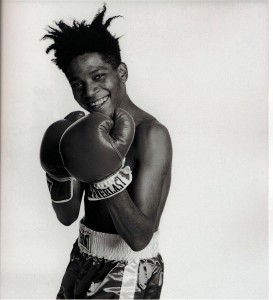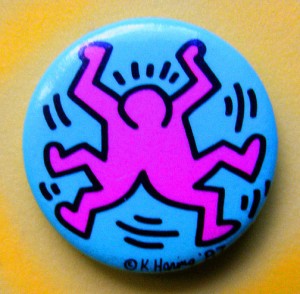
"I'm always amazed at how people come up with things. Like Jean-Michel." (Image by Michael Halsband.)
From Rene Ricard’s 1981 Artforum article, “The Radiant Child,” which was the first major piece to look at the work of emerging NYC artists Jean-Michel Basquiat and Keith Haring:
“Graffiti refutes the idea of anonymous art where we know everything about a work except who made it: who made it is the whole Tag. Blade, Lady Pink, Pray, Sex, Taki, Cliff 159, Futura 2000, Dondi, Zephyr, Izzy, Haze, Daze, Fred, Kool, Stan 153, SAMO, Crash. (Crash is still bombing.) But trains get buffed (the damnatio memoriae of the Transit Authority), and with the need for identity comes the artist’s need for identification with the work, and to support oneself by the work is the absolute distinction between the amateur and the pro. Therefore, the obvious was to raise oneself by the supreme effort of will from the block, from the subway, to the Mudd, to the relative safety and hygiene of the gallery. Because an artist is somebody. Say what you will about group shows and collaborative enterprise: Das Kapital was written by one man. This is no graffito, this is no train, this is a Jean-Michel Basquiat. This is a Keith Haring.
 Both these artists are a success in the street where the most critical evaluation of a graffito takes place. Jean-Michel is proud of his large SAMO Tag in a schoolyard, surrounded by other Tags on top of Tags, yet not marked over. This demonstrates respect for the artist as not just a graffitist but as an individual, the worth of whose Tag is recognized. There’s prestige in not being bombed over. There are also fake SAMOS and Harings as well as a counter-Haring graffitist who goes around erasing him. The ubiquity of Jean-Michel’s SAMO and Haring’s baby Tags has the same effect as advertising; so famous now is that baby button that Haring was mugged by four 13-year-olds for the buttons he was carrying (as well as for his Sony Walkman.) The Radiant Child on the button is Haring’s Tag. It is a slick Madison Avenue colophon. It looks as if it’s always been there. The greatest thing is to come up with something so good it seems as if it’s always been there, like a proverb. Opposite the factory-fresh Keith Haring is Jean-Michel’s abandoned cityscape. His prototype, the spontaneous collage of peeling posters, has been there for everyone’s ripping off. His earlier paintings were the logical extension of what you could do with a city wall. (For the moment he’s stopped the collage.) His is a literal case of bringing something in off the street but with the element of chance removed. I’m always amazed at how people come up with things. Like Jean-Michel. How did he come up with the words he puts all over everything, his way of making a point without overstating the case, using one or two words he reveals a political acuity, gets the viewer going in the direction he wants, the illusion of the bombed-over wall. One or two words containing a full body. One or two words on a Jean-Michel contain the entire history of graffiti. What he incorporates into his pictures, whether found or made, is specific and selective. He has a perfect idea of what he’s getting across, using everything that collates to his vision.”
Both these artists are a success in the street where the most critical evaluation of a graffito takes place. Jean-Michel is proud of his large SAMO Tag in a schoolyard, surrounded by other Tags on top of Tags, yet not marked over. This demonstrates respect for the artist as not just a graffitist but as an individual, the worth of whose Tag is recognized. There’s prestige in not being bombed over. There are also fake SAMOS and Harings as well as a counter-Haring graffitist who goes around erasing him. The ubiquity of Jean-Michel’s SAMO and Haring’s baby Tags has the same effect as advertising; so famous now is that baby button that Haring was mugged by four 13-year-olds for the buttons he was carrying (as well as for his Sony Walkman.) The Radiant Child on the button is Haring’s Tag. It is a slick Madison Avenue colophon. It looks as if it’s always been there. The greatest thing is to come up with something so good it seems as if it’s always been there, like a proverb. Opposite the factory-fresh Keith Haring is Jean-Michel’s abandoned cityscape. His prototype, the spontaneous collage of peeling posters, has been there for everyone’s ripping off. His earlier paintings were the logical extension of what you could do with a city wall. (For the moment he’s stopped the collage.) His is a literal case of bringing something in off the street but with the element of chance removed. I’m always amazed at how people come up with things. Like Jean-Michel. How did he come up with the words he puts all over everything, his way of making a point without overstating the case, using one or two words he reveals a political acuity, gets the viewer going in the direction he wants, the illusion of the bombed-over wall. One or two words containing a full body. One or two words on a Jean-Michel contain the entire history of graffiti. What he incorporates into his pictures, whether found or made, is specific and selective. He has a perfect idea of what he’s getting across, using everything that collates to his vision.”
••••••••••
Just under a year before Keith Haring died:
